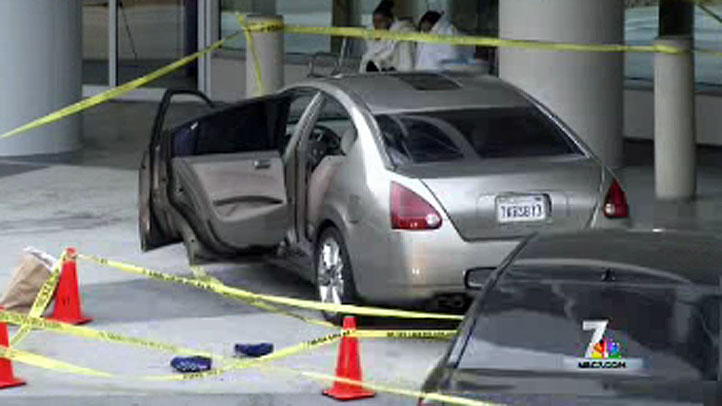In an emotional interview, the driver of the limousine where nine women were on their way to a Bay Area bridal shower on Saturday, described how fast the flames engulfed the white Lincoln Town Car he was driving when five women died.
"There were too many flames," Orville Brown, 46, of Oakland and a driver for Limo Stop, said on Monday in an interview with NBC Bay Area. "The flames were just bursting. When the (women) opened the door, it oxygenated the fire, and it spread so fast."
Brown was picking up nine women on Saturday before 10 p.m. in Alameda and heading toward Foster City for a bachelorette party, when his limo caught fire for unknown reasons on Saturday, and claimed the lives of five women, including the bride. The victim's sister-in-law, Lovela Nicolas, identified the bride as Neriza Fojas.A family member told NBC Bay Area she was recently married here in the United States, but she was also planning a wedding in the Philippines on June 19.
As of Monday morning, Valley Medical Center in San Jose said that Jasmine Desguia, 34, of San Jose and Amalia Loyola, 48, of San Leandro were still in critical condition. Stanford Medical Center would not discuss the details of Mary G. Guardiano, 42, of Alameda.
Neila Arrellano, 36, who was released from Stanford Medical Center, and who is a nurse who works at the Fruitvale Health Center in Oakland, described through tears that she was yelling at Brown to pull over.
"Stop the car, stop the car," she recalled telling Brown. "I told you, there is smoke."
She said her friends were heading to the Crowne Plaza in Foster City for a "wedding celebration," because it was supposed to be a night of "fun."
Arrellano, a nurse who works at the Fruitvale Health Center in Oakland, described through tears that she was yelling at Brown to pull over.
"Stop the car, stop the car," she recalled telling Brown. "I told you, there is smoke."
Arrellano told NBC the driver wasn't paying attention because he was on the phone. “Open the door. Open the door. But he didn’t do anything. He was on the phone,” Arrellano said.
Brown's brother, Lewis Brown, responded to that claim. He told NBC Bay Area they think she was confused. "The partition was solid. He [Orville Brown] was not on the phone. He added that the partition wasn't made of see-through glass.
The driver said he initially thought the women were asking him to pull the vehicle over so that they could get out and smoke a cigarette. Then he realized that they were complaining of smoke in the back.
The San Mateo County Coroner has not yet released the names of the other victims, but Community Regional Medical Center in Fresno released the name of a second victim on Monday. They said a nurse named Michelle Estrera also died in the fire. Estrera and Fojas were both nurses.
Brown called all the women "beautiful," and that when he went to go pick them up, he was honored and excited for them to have a wonderful night.
"Everything was fine," he said. "The music was on, they were having fun."
At some point, one of the women told him there was "smoke," but he didn't realize the car was on fire. He thought she wanted a cigarette, and he didn't immediately respond to the emergency.
RAW AUDIO: Limo Driver Says Women in the Car Said to "Pull Over"
Then he saw the panic and "grief" on her face and he started dialing 911, but had trouble because his hands were shaking so badly.
"It was horrific," he said. "The flames were so high. I didn't know how to explain it. It was a weird situation. I've never been in one like that before."
He said the flames started spewing odors, such as plastic, rubber and wood. "It was a nasty, toxic smell," he said.
He added that he wished there was a law that required fire departments to have substations on bridges. It seemed to take forever for firefighters to arrive because they had to circle back on the San Mateo Bridge to help.
The California Highway Patrol said Monday that the limousine where five women died on Saturday was authorized to carry eight passengers, not nine.
Capt. Mike Maskarich said that Brown, however, was properly licensed to operate the white stretch car, considered a "chartered party vehicle," despite the fact that there was one more passenger than allowed.
Limo Stop Owner Kultar Singh deferred all comment to his lawyer, Doug Sears, of Sacramento, who was not immediately available for comment.
In a separate interview on Monday, Brown told NBC Bay Area that he thought "a limo could hold more than that, to be honest with you."
He added: "I don't make the rules I'm just a driver."
Below, survivors Neila Arrellano describes through tears how events surrounding a limo fire that killed five of her friends unfolded.
MORE:
- CHP: Limo Authorized to Carry 8 Passengers, Not 9
- New Bride Among Five Killed in Limo Fire on Bridge
Photo Credit: NBC Bay Area











